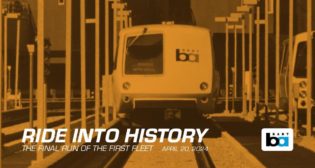In the April 12, 1976 cover story of Railway Age, “Day 1 on the Washington Metro,” Editor-In-Chief Luther Miller wrote: “Maybe it won’t last … But let it be recorded that on March 29, 1976, Washingtonians embraced their new Metro with affection, enthusiasm, and the indulgent understanding that an infant crawls before it walks and sometimes even falls flat on its face.”
From a ceremonial launch two days earlier on March 27, 1976, Washington Metro has grown from an initial 4.6-mile, five-station operation on the nation’s bicentennial, and has never looked back. Today Metrorail spans 106 miles and serves 86 stations, with another five under construction, and extensions reaching ever deeper into the Virginia suburbs of the nation’s capital (and, less directly, improving rail connections with D.C.’s corresponding Maryland suburbs).
Back then, Washington Metro also was the new subway kid in the U.S. marketplace, commencing operations roughly four years after BART began serving the San Francisco Bay Area, a time when many thought passenger rail transit was destined for oblivion. Such defeatism is long gone, but now, as then, Metro receives intense public scrutiny, operating as it does in a dual arena of local and national politics, and struggling to both operate and expand with a hodgepodge of funding sources. Farebox and related revenue cover about 57% of Metro operating expenses, higher than many U.S. public transport systems. The remainder is an ongoing problematic exercise, since Metrorail has no dedicated source of funding. Washington Metropolitan Transit Authority (WMATA) must ask several entities to contribute, with the District of Columbia, Maryland’s Montgomery and Prince George’s counties, Virginia’s Fairfax and Arlington counties, and the Virginia cities of Alexandria, Falls Church, and Fairfax contributing varying amounts each year, depending on local fiscal stresses and each entity’s own perceived interest in benefitting from—or feeling neglected by—Metrorail operations and planning.
Despite such ongoing angst, Metrorail’s worth to the city and region is now generally beyond dispute, even by most strident anti-rail partisans, as it handles 594,000 riders on an average day and offers a true transport alternative to a city renowned, even by American standards, for automotive overload.
New gear for lines old and new
The commitment is exemplified by the $886 million order for 428 7000-Series cars, awarded to Kawasaki Rail Car USA in May 2010. Approximately 300 cars will be used to replace Metro’s older 1000-Series cars, in service since Washington Metro began operations in 1976. Another 128 cars will be used for Metro’s planned 23-mile service extension to Dulles International Airport. The cars will begin arriving on the property for revenue service next year, with delivery scheduled for completion by 2016.
Following prototype construction of the 7000-Series cars in Kobe, Japan, Kawasaki Rail Car is producing the new cars at its plants in Lincoln, Neb., and Yonkers, N.Y. The cars will join older but still viable 5000-Series cars from CAF, built in the early 2000s, and 6000-Series cars built by Alstom, added to the roster between 2005 and 2007.
The cars targeted for the Dulles Corridor can’t arrive too soon. The first 11.7 miles of the route are under construction, with Bechtel the lead contractor, and completion slated for late 2013. Phase One would extend Metro to Wiehle-Reston East in Reston, Va. Phase 2, reaching Dulles International Airport itself, would also reach beyond the airport to terminate on Virginia state highway 772.
Less ambitious, but perhaps just as beneficial, is a renewed interest in revamping Metro’s stop at Union Station, judged by most as woefully inadequate in handling peak-period ridership from passengers heading to or from Amtrak, Maryland MARC, and VRE trains, as well as WMATA bus services serving the restored rail station above the subway.
New rail modes eyed
Though not directly overseeing implementation, Metro officials have offered significant political guidance and planning assistance to the Maryland Transit Administration in advancing the proposed Purple Line light rail transit project, spanning two Maryland counties and offering intermodal connections with Metrorail at four locations, including LRT’s termini in New Carrollton (Orange Line) and Bethesda (Red Line). The 16-mile line in essence forms a circumferential route that would act as both feeder and distributor to Metro’s radial rapid transit network.
Within the district, WMATA is aiding the District Department of Transportation as DDOT advances a program to layer Metro rail service with eight streetcar routes totaling 37 miles. Late last month DDOT noted active construction work was planned for the Anacostia and H Street/Benning Road streetcar corridors, in the city’s Northeast.
H Street/Benning Road streetcars, plying a 2.2-mile route, will add to the growing rail and intermodal mix at Washington Union Station. Standing ready are three Skoda-Inekon streetcars; three more cars, to be built by Clackamas, Ore.-based United Streetcar, LLC, are expected to arrive on the property by late 2013. DDOT officials now expect H Street/Benning to begin service in late 2013 or early 2014, though the project’s completion has been repeatedly delayed.
Construction also is commencing on the Anacostia Initial Line Segment, originally planned as the first streetcar segment. The 1.1-mile route will connect Metro’s Anacostia Station with the Joint Base Anacostia-Bolling (JBAB), via Firth Sterling Avenue and South Capitol Street.
Just outside the district, a streetcar proposal for Alexandria and neighboring Arlington County has incorporated WMATA input, as two halves of one line would each join at Metro’s Pentagon City (Va.) station. Here, too, WMATA officials have assisted city and county authorities.




